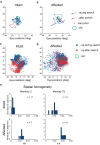Visual instrumental learning in blindsight monkeys
- PMID: 34285293
- PMCID: PMC8292513
- DOI: 10.1038/s41598-021-94192-7
Visual instrumental learning in blindsight monkeys
Abstract
Blindsight is the residual visuo-motor ability without subjective awareness observed after lesions of the primary visual cortex (V1). Various visual functions are retained, however, instrumental visual associative learning remains to be investigated. Here we examined the secondary reinforcing properties of visual cues presented to the hemianopic field of macaque monkeys with unilateral V1 lesions. Our aim was to test the potential role of visual pathways bypassing V1 in reinforcing visual instrumental learning. When learning the location of a hidden area in an oculomotor search task, conditioned visual cues presented to the lesion-affected hemifield operated as an effective secondary reinforcer. We noted that not only the hidden area location, but also the vector of the saccade entering the target area was reinforced. Importantly, when the visual reinforcement signal was presented in the lesion-affected field, the monkeys continued searching, as opposed to stopping when the cue was presented in the intact field. This suggests the monkeys were less confident that the target location had been discovered when the reinforcement cue was presented in the affected field. These results indicate that the visual signals mediated by the residual visual pathways after V1 lesions can access fundamental reinforcement mechanisms but with impaired visual awareness.
© 2021. The Author(s).
Conflict of interest statement
The authors declare no competing interests.
Figures






Similar articles
-
Contribution of the Pulvinar and Lateral Geniculate Nucleus to the Control of Visually Guided Saccades in Blindsight Monkeys.J Neurosci. 2021 Feb 24;41(8):1755-1768. doi: 10.1523/JNEUROSCI.2293-20.2020. Epub 2020 Dec 18. J Neurosci. 2021. PMID: 33443074 Free PMC article.
-
Informative Cues Facilitate Saccadic Localization in Blindsight Monkeys.Front Syst Neurosci. 2017 Feb 10;11:5. doi: 10.3389/fnsys.2017.00005. eCollection 2017. Front Syst Neurosci. 2017. PMID: 28239342 Free PMC article.
-
Neural Mechanism of Blindsight in a Macaque Model.Neuroscience. 2021 Aug 10;469:138-161. doi: 10.1016/j.neuroscience.2021.06.022. Epub 2021 Jun 19. Neuroscience. 2021. PMID: 34153356 Review.
-
Signal detection analysis of blindsight in monkeys.Sci Rep. 2015 May 29;5:10755. doi: 10.1038/srep10755. Sci Rep. 2015. PMID: 26021856 Free PMC article.
-
Blindsight revisited.Curr Opin Neurobiol. 1996 Apr;6(2):215-20. doi: 10.1016/s0959-4388(96)80075-4. Curr Opin Neurobiol. 1996. PMID: 8725963 Review.
Cited by
-
What Is It Like to Be a Bass? Red Herrings, Fish Pain and the Study of Animal Sentience.Front Vet Sci. 2022 Apr 27;9:788289. doi: 10.3389/fvets.2022.788289. eCollection 2022. Front Vet Sci. 2022. PMID: 35573409 Free PMC article. Review.
-
From internal models toward metacognitive AI.Biol Cybern. 2021 Oct;115(5):415-430. doi: 10.1007/s00422-021-00904-7. Biol Cybern. 2021. PMID: 34677628 Free PMC article.
-
Phylogenetic view of the compensatory mechanisms in motor and sensory systems after neuronal injury.Curr Res Neurobiol. 2022 Oct 17;3:100058. doi: 10.1016/j.crneur.2022.100058. eCollection 2022. Curr Res Neurobiol. 2022. PMID: 36304591 Free PMC article. Review.
-
Ameliorating Hemianopia with Multisensory Training.J Neurosci. 2023 Feb 8;43(6):1018-1026. doi: 10.1523/JNEUROSCI.0962-22.2022. Epub 2023 Jan 5. J Neurosci. 2023. PMID: 36604169 Free PMC article.

